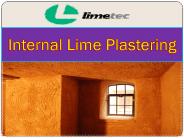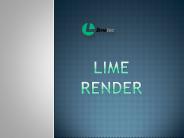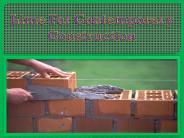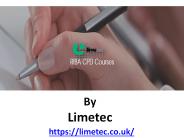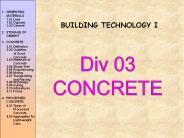What Is Hydraulic Lime PowerPoint PPT Presentations
All Time
Recommended
Welcome to our blog, where we explore the world of lime and its various uses. Lime has been used for construction and building purposes for centuries. Additionally, even today, it continues to be a popular building material in the world of construction. One of the most significant distinctions within the lime category is hydraulic and non-hydraulic lime.
| PowerPoint PPT presentation | free to download
Ready mixed colour hydraulic lime mortars are the perfect choice for listed buildings and conservation areas which require repairs or new builds.
| PowerPoint PPT presentation | free to download
hydraulic lime has been used as a binder for brick, stones and masonry for thousands of years. Before 1900 nearly all buildings constructed across Europe will have been built using it, and many parts of Europe are still using it for new builds.
| PowerPoint PPT presentation | free to download
We pride ourselves on supplying the finest lime mortar at competitive prices, backed up by friendly technical advice and after care. We have our own expert team with over a decade of experience specialising in conservation of listed buildings, offering practical advice based upon real world experience.
| PowerPoint PPT presentation | free to download
Lime Mortar has been used in the construction of buildings for over 2000 years, and used on the most iconic historical landmarks across the world. For example, the Great Wall of China, the Houses of Parliament and Rome Colosseum. These historical buildings are still here today, due to its unique beneficial properties.
| PowerPoint PPT presentation | free to download
Lime mortar has been used in the construction of buildings for over 2000 years, and has been used on the world most iconic historical landmarks across the world; for example, the Great Wall of China, the Houses of Parliament and the Colosseum. These historical buildings are still here today, due to its beneficial properties.
| PowerPoint PPT presentation | free to download
A damp building can cost a considerable amount of time and money to put right. Damp allows mold and fungi to prosper, which is directly linked to respiratory problems and affect asthma sufferers . Old buildings, are most vulnerable to damp, due to being built with porous material such as; cob, stone and rab, which will hold moisture within the walls of the structure.
| PowerPoint PPT presentation | free to download
Limetec NHL 3.5 Moderately Hydraulic Lime Mortar (HLM 3.5) can be used for permeable masonry materials which is mainly used above ground.
| PowerPoint PPT presentation | free to download
Lime mortar benefits in the modern world of Construction https://limetec.co.uk/hydraulic-lime-mortars/
| PowerPoint PPT presentation | free to download
When people refer to lime mortar they're generally referring to mortar made with hydraulic lime or fat lime putty, sand and no cement. However, for most modern bricklayers and builders, the only exposure they've had to lime products is hydrated lime.
| PowerPoint PPT presentation | free to download
Natural Hydraulic Lime mortar consists of two building materials, lime and sand. They can be used for a variety of applications for laying brickwork, bedding tiles, rendering and plastering
| PowerPoint PPT presentation | free to download
Lime Mortar has been used in the construction of buildings for over 2000 years, and used on the most iconic historical landmarks across the world. For example, the Great Wall of China, the Houses of Parliament and Rome Colosseum. These historical buildings are still here today, due to its unique beneficial properties.
| PowerPoint PPT presentation | free to download
We pride ourselves on supplying the finest lime mortar at competitive prices, backed up by friendly technical advice and aftercare. We have our expert team with over a decade of experience specialising in the conservation of listed buildings, offering practical advice based on real-world experience.
| PowerPoint PPT presentation | free to download
The promotion of modern gypsum-based plasters has led to the almost complete demise of lime plastering, and of many of the traditional skills associated with the craft. This has been exacerbated by the plastering trade being divided into flat and decorative work
| PowerPoint PPT presentation | free to download
Limetec lime putty is produced by slaking Quicklime in an excess of water. Our lime putty is mainly used for old buildings, and historic properties where maximum permeability and flexibility is required.
| PowerPoint PPT presentation | free to download
Lime render has been used in construction of building and has been dated as far back to the 4th century and is still used today in modern new builds.
| PowerPoint PPT presentation | free to download
Our mortars are ready mixed at our state of the art factory. This removes the possibility of inconsistent colour and strength that can occur during site mixing.
| PowerPoint PPT presentation | free to download
The benefits of using lime to create a vapour open construction are well known for historic solid walled buildings, however its use in modern construction is not so well documented.
| PowerPoint PPT presentation | free to download
Our mortars are ready mixed at our state of the art factory. This removes the possibility of inconsistent colour and strength that can occur during site mixing.
| PowerPoint PPT presentation | free to download
Lime render has been used in construction of building and has been dated as far back to the 4th century and is still used today in modern new builds.
| PowerPoint PPT presentation | free to download
Find out why London Lime Mortar is changing the way for listed buildings across London
| PowerPoint PPT presentation | free to download
Hair or Fibres have traditionally been used as reinforcement in lime renders as a means of improving tensile strength and to reduce shrinkage cracking. Introduced into the mix by teasing the hair into the mix prior to the mortars use. This is a time-consuming job as it involves teasing the hair into the mix as it is mixed. Clumps of hair simply cannot be placed into the mixer as they will remain in the mix as large balls of hair and will not part no matter what type or method of mixing is used.
| PowerPoint PPT presentation | free to download
The 20% difference in bulk volume demonstrates the need to measure cement by mass instead of volume for batching concrete. (68970) Fig. 2-49.
| PowerPoint PPT presentation | free to view
Lime has been used for thousands of years and we see many examples of historical buildings and structures which are still standing today. In recent history, with the expansion of the railwayindustry, we saw lime mortar used extensively in the construction of bridges, tunnels and viaducts.
| PowerPoint PPT presentation | free to download
A damp building can cost a considerable amount of time and money to put right. Damp allows mold and fungi to prosper, which is directly linked to respiratory problems and affect asthma sufferers .
| PowerPoint PPT presentation | free to download
The use of natural lime mortars and renders has increased considerably in recent years compared to just a couple of decades ago. These simple, basic materials are fundamentally important to the long term survival of historic buildings, yet there are many who still regard their use with suspicion.
| PowerPoint PPT presentation | free to download
Sands specified for concrete tend to be used for mortars regardless of ... The term Kandoxi was introduced by Joseph Davidovits of geopolymer fame for mixed ...
| PowerPoint PPT presentation | free to download
New Materials Based on the Addition of Reactive Magnesia to Hydraulic Cements. Hobart, Tasmania, Australia All I ask is that the industry think about what I am saying.
| PowerPoint PPT presentation | free to download
The industry report package Lime Markets in the World to 2017 - Market Size, Trends, and Forecasts offers the most up-to-date perspective on the actual market situation, trends, and future outlook for limes in different countries around the world. The studies include historic market data from 2006 to 2012 and forecasts until 2017 which makes the reports an invaluable resource for industry executives, marketing, sales and product managers, analysts, and other people looking for key market insights in a readily accessible and clearly presented format. For More Details: http://www.researchonglobalmarkets.com/lime-markets-in-the-world-to-2017-market-size-trends-and-forecasts.html
| PowerPoint PPT presentation | free to download
Marketreportsonchina.com presents a report on “Lime Market in China to 2019 - Market Size, Development, and Forecasts”. The Report on Plan and develop marketing, market-entry, market expansion, and other business strategies by identifying the key market opportunities and prospects.
| PowerPoint PPT presentation | free to download
Title: Slide 1 Last modified by: John Harrison Created Date: 7/15/2003 10:26:18 PM Document presentation format: On-screen Show Company: none Other titles
| PowerPoint PPT presentation | free to download
90 day old specimens made with 1:3 lime putty : aggregate. Calcitic stone aggregate ... specimens made with lime putty. Calcitic stone aggregate. Silicate sand ...
| PowerPoint PPT presentation | free to view
The requirements for totally hydraulic limes and all hydraulic concretes is to ... For carbonating eco-cements and lime mortars on the on the hand the matrix must ' ...
| PowerPoint PPT presentation | free to view
În industrii și domenii de știință, tehnologii anterior nu a acceptat, unele dintre care a fost utilizat pe scară largă pentru aplicațiile comercializate, sunt treptat re-confirmat de către cadrele universitare occidentale de masă. Următoarea fază este modul în care mass-media de masă occidentale de diferite niveluri (de la stiri, rapoarte de știință, la Wikipedia) vor să-și exprime acestor confirmări. / Across industries and science fields, previously not accepted technologies, some of which has been widely used for commercialized applications, are gradually being re-confirmed by mainstream Western academics. The next phase is how Western mainstream media of various levels(from news, science reports, to Wikipedia) are going to express these confirmations.
| PowerPoint PPT presentation | free to download
... stabilised earth blocks, pavers, roof tiles pavement and mortars that utilise large quantities of waste and products where sustainability, ... red mud etc.: They ...
| PowerPoint PPT presentation | free to view
Cement is a grey coloured, inorganic powdery substance made by calcining lime and clay. It has excellent hydraulic binding properties and results in a rock-like substance when mixed with sand, gravel, water, etc. It is used in the production of concrete, stucco, mortar, grouts, etc. the global ghee market has grown at a CAGR of 3.8% during 2009-2016, reaching a volume of 5.4 Million Tons in 2016. To get more information on cement market, Click here @ http://www.imarcgroup.com/cement-manufacturing-plant Request sample report @ http://www.imarcgroup.com/request?type=report&id=525&flag=B Find more reports on chemical & material research @ http://www.imarcgroup.com/categories/chemicals-market-reports Contact Us IMARC Group 309 2nd St, Brooklyn, NY 11215, USA Website: www.imarcgroup.com Email: sales@imarcgroup.com USA: +1-631-791-1145 Follow us on twitter: @imarcglobal
| PowerPoint PPT presentation | free to download
Our RIBA CPD presentation on the Benefits of lime mortar is interactive seminar with samples of our lime mortar materials and the benefits of use for building renovation, restoration and sustainability.
| PowerPoint PPT presentation | free to download
Limepoint is a lime pointing mortar designed specifically for pointing joints by a modern mortar gun or bag injection.
| PowerPoint PPT presentation | free to download
IJP, Countryside Building Properties of Lime-based Materials They are porous and absorb moisture from the surrounding bricks or stones.
| PowerPoint PPT presentation | free to download
Completing a Loan Application Colorado Agriculture Business You ... You pay your neighbor $1000 in October and $1100 in November to use his ... You buy lime in ...
| PowerPoint PPT presentation | free to download
Limepoint is a lime pointing mortar designed specifically for pointing joints by a modern mortar gun or bag injection. Limepoint is perfect solution for stone cladding walls or for conventional wall, which require repointing.
| PowerPoint PPT presentation | free to download
Agenda Basic Principles of Peristaltic Pumping General Introduction to Hydraulics Introduction to Hose pumps ... Ground Beef, Chicken ... pumps were used as fire ...
| PowerPoint PPT presentation | free to view
... Water + high pH Ca++ + = Ca++ Ca++ Ca++ Clay (SiO2 ... story ! * Lime Applications Soil Treatment Soil improvement ... lime, it gives rise to heat.
| PowerPoint PPT presentation | free to download
Portland cement is the most commonly used grade of cement around the world as a basic ingredient of concrete, mortar, stucco and grout. It was developed from different kinds of lime in England in the mid-nineteenth century.Types of Portland cement, PPC, Portland Slag Cement, OPC 33 Grade, 43 Grade & 53 Grade.
| PowerPoint PPT presentation | free to download
Hydration chemical ... invents Portland Cement Hydration The chemical reaction between hydraulic cement and water forming new compounds most of which have ...
| PowerPoint PPT presentation | free to view
CEMENTING MATERIALS 1.01 Lime 1.02 Gypsum BUILDING TECHNOLOGY I 1 ... CELITE To impart water-repellant or waterproofing qualities, e.g., hydrated lime, waterproofing ...
| PowerPoint PPT presentation | free to download
Reacts with lime in the presence of water to form cementitious compounds. ... superfine material - has to be well dispersed to be effective ...
| PowerPoint PPT presentation | free to view
Spatial distribution of hydraulic properties also effects subsurface processes ... durability is essential to major engineering projects such as roads and waterways ...
| PowerPoint PPT presentation | free to view
Prevent Hydraulic Overloading of Secondary Clarifiers ... Aquacluture Systems for Wastewater Treatment Seminar Proceedings and Engineering ...
| PowerPoint PPT presentation | free to view
Greeks: lime, sand, Santorin Earth, powdered pottery ... 'cement': in its late Latin and Old French designated materials now classed as ...
| PowerPoint PPT presentation | free to view
Ceramic Tiles. Flat glass. Lime, Gypsum, Mortar. Steel ... ASSOPIASTRELLE Ceramic Tiles. ASSOVETRO Flat glass. CAGEMA Lime, Gypsum, Mortar. FEDERACCIAI Steel ...
| PowerPoint PPT presentation | free to view
Romans are commonly given the credit for the development of hydraulic cement, ... Oyster and clam shells. Travertine. Tuff. LIMESTONES ...
| PowerPoint PPT presentation | free to view
John Deere 3325 Professional Turf Mower Service Repair Manual Instant Download (tm1427)
| PowerPoint PPT presentation | free to download
John Deere 756 Compact Utility Tractor Service Repair Manual Instant Download
| PowerPoint PPT presentation | free to download
John Deere 955 Compact Utility Tractor Service Repair Manual Instant Download
| PowerPoint PPT presentation | free to download
John Deere 856 Compact Utility Tractor Service Repair Manual Instant Download
| PowerPoint PPT presentation | free to download














